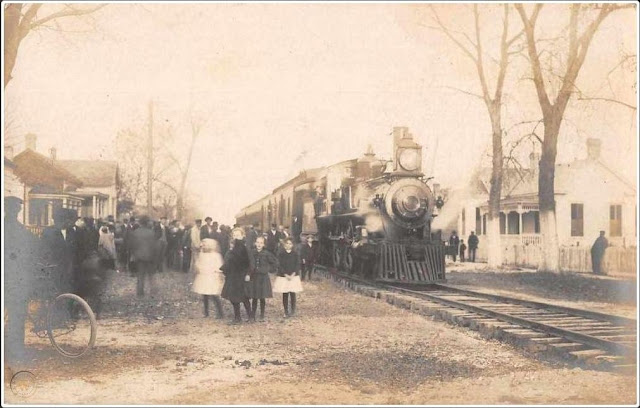1 B&M Railroad Trestle (center) 2 B&M Warehouse
3 Carteret Quick Freeze 4 Noe Boat Yard
5 Beaufort Bridge to Ann Street (right) 6 Gallants Channel
7 Broad Street 8 Ann Street
9 Grayden Paul Bridge to Cedar Street late 1950s (left) 10 Cedar Street-Hwy 70
_________________________________________________________________
_________________________________________________________________
RAILROAD BRIDGE - Built 1906
Prior
to train service to Beaufort, visitors who came by train were met at the
railroad terminus in Morehead City (completed in 1858) and brought to town by boat. In
1905, plans were finally made to extend the railroad to Beaufort. Mayor William Franklin Dill, and Beaufort citizens, met
with a railroad representative, who estimated a cost of $150,000 to bring the
train to town. A causeway was constructed, with trestles and tracks over the
marshland and Gallant's Channel, as tracks were laid down Broad Street. Before
a train junction (wye) was completed, the first trains backed into town. Nathaniel
Hancock Russell was the engineer.
 |
| Image scanned from Beaufort-An Album of Memories by Jack Dudley |
One of the first trains to arrive in 1907, engine first.
On June 8, 1907 Beaufort celebrated the building of the railroad bridge and the first passenger train into town.
___________________________________________________________________
___________________________________________________________________
MOREHEAD CITY-BEAUFORT HIGHWAY BRIDGE
Built 1927
In his book Beaufort-by-the-Sea - Memories of a Lifetime,
Neal Willis wrote, "Before the highway was built between Beaufort and
Morehead City, the only way from Beaufort to Morehead was by train, boat
or to drive around on New Bern Road. Later a ferry ran between the two
towns. It carried passengers and three or four cars. The number of
passengers varied. It was very popular. Leaving a dock on Front Street
twice a day, it ran to a dock on the Morehead waterfront."
 |
 The Morehead City-Beaufort Bridge was constructed in 1927. Spanning 2.218 miles in length from the Atlantic Hotel in Morehead City to Ann Street in Beaufort, 5100 feet of causeway connected two drawbridges.
The Morehead City-Beaufort Bridge was constructed in 1927. Spanning 2.218 miles in length from the Atlantic Hotel in Morehead City to Ann Street in Beaufort, 5100 feet of causeway connected two drawbridges. | ||
| Morehead City-Beaufort Bridge Looking East |
 |
| North Carolina Postcard Collection |
With few cars in town, many people hitchhiked to Morehead City. When anyone walked by "Miss Nannie" Geoffroy's porch at the corner of Ann and Moore, they would hear her green parrot squawk, “Morehead?—Going to Morehead?” Interestingly, Jean Kell worked for "Miss Nannie" during the depression; the parrot called her "Ms. Kell."
In the beginning, owners of the first automobiles and residents believed that gas in containers might ignite, therefore, the fuel was kept on one of the barrier islands; when needed, someone would row over to retrieve a container.
In the beginning, owners of the first automobiles and residents believed that gas in containers might ignite, therefore, the fuel was kept on one of the barrier islands; when needed, someone would row over to retrieve a container.
Again, Neal Willis wrote, "A Chevrolet car cost about four to five hundred dollars. Gas was 12 cents a gallon and was [eventually] pumped by hand from underground tanks. Motor oil was pumped from a container into pint and quart jars with spouts. There was no antifreeze. Radiators had to be drained at night and filled the next morning."
_______________________________________________________________
_______________________________________________________________
GRAYDEN PAUL BRIDGE - Built 1957
The Grayden Paul Bridge, owned by the NC Department of Transportation, was a bascule-type bridge constructed in 1957. In 2018, the bridge was closed and removed, after a new high-rise bridge was constructed over Gallants Channel.
.jpg)


